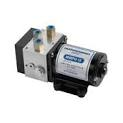I was hoping to find a mechanic who could hook up my new autopilot pump. I have one last call in, but I can already see where this is going. If it's going to get done before June, there's a good chance it's going to be me doing it.
So, all you hydraulic experts, I'll have some questions.
First, some background. It's a two-helm system, three copper tubes, reservoir in the ER, relief valve aft not too far from the cylinder.
1) Pump Location. I'm thinking the best place for the pump would be in front of and below the lower helm. From there, the three hydraulic lines disappear below decks and ultimately "T" in with the three from the flybridge. Any reason this would be a bad spot?
2) Connection Location. Could I "T" off the connections at the helm pump? Do I have to cut in somewhere between it and the rest of the system?
3) Tools and Parts. I've never fabricated hydraulic lines, only disconnected & reconnected them. What do I need? Flaring tool? How fancy does it need to be? Any decisions to make on which fittings to buy? Copper tubing or something else?
I'm sure there will be more. Thanks in advance for any suggestions.
So, all you hydraulic experts, I'll have some questions.
First, some background. It's a two-helm system, three copper tubes, reservoir in the ER, relief valve aft not too far from the cylinder.
1) Pump Location. I'm thinking the best place for the pump would be in front of and below the lower helm. From there, the three hydraulic lines disappear below decks and ultimately "T" in with the three from the flybridge. Any reason this would be a bad spot?
2) Connection Location. Could I "T" off the connections at the helm pump? Do I have to cut in somewhere between it and the rest of the system?
3) Tools and Parts. I've never fabricated hydraulic lines, only disconnected & reconnected them. What do I need? Flaring tool? How fancy does it need to be? Any decisions to make on which fittings to buy? Copper tubing or something else?
I'm sure there will be more. Thanks in advance for any suggestions.






